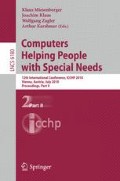Abstract
It is difficult for blind persons to appreciate painting. To facilitate the appreciation by tactile perception, the Francesco Cavazza Institute for blind in Italy is developing three-dimensional tactile painting for blind persons. We are developing a system which product tactile paintings utilized three-dimensional model making technology cooperation with Cavazza Institute. This method enables us to manufacture paintings of varied sizes. In this study, we examined the possibility of down-sizing products. We find blind persons to be useful means of materials which reaffirm the painting image.
Access this chapter
Tax calculation will be finalised at checkout
Purchases are for personal use only
Preview
Unable to display preview. Download preview PDF.
References
Aleman, A., van Lee, L., Mantione, M.H.M., Verkoijen, I.G., de Haan, E.H.F.: Visual imagery without visual experience: evidence from congenitally totally blind people. NeuroReport 12, 2601–2604 (2001)
Anderson, J.R.: Arguments concerning representations for mental imagery
Psychological Review 85, 249–277 (1978)
De Beni, R., Cornoldi, C.: Imagery limitations in totally congenitally blind subjects. Journal of Experimental Psychology: Learning, Memory and Cognition 14, 650–655 (1988)
Heller, M.A.: Tactile memory in sighted and blind observers: the influence of orientation and rate of presentation. Perception 18, 121–133 (1989)
Kennedy, J.M.: Drawing and the Blind Picture to touch. Yale university press, New Haven (1993)
Oouchi, S.: Utilizing a 3D scanner to produce and reproduce educational materials to learn “haptic Paintings” for persons with visual impairments. In: Proceedings of the 30th sensory subsutitution symposium, pp. 127–132 (2004) (in Japananese)
Secchi, L.: L’ educazione estetica per l’integrazione. Carocci, Rome (2004)
Zimler, J., Keenan, J.M.: Imagery in the congenitally blind: How visual are visual images? Journal of Experimental Psychology: Learning, Memory and Cognition 9, 269–282 (1983)
Author information
Authors and Affiliations
Editor information
Editors and Affiliations
Rights and permissions
Copyright information
© 2010 Springer-Verlag Berlin Heidelberg
About this paper
Cite this paper
Oouchi, S., Yamazawa, K., Secchi, L. (2010). Reproduction of Tactile Paintings for Visual Impairments Utilized Three-Dimensional Modeling System and the Effect of Difference in the Painting Size on Tactile Perception. In: Miesenberger, K., Klaus, J., Zagler, W., Karshmer, A. (eds) Computers Helping People with Special Needs. ICCHP 2010. Lecture Notes in Computer Science, vol 6180. Springer, Berlin, Heidelberg. https://doi.org/10.1007/978-3-642-14100-3_79
Download citation
DOI: https://doi.org/10.1007/978-3-642-14100-3_79
Publisher Name: Springer, Berlin, Heidelberg
Print ISBN: 978-3-642-14099-0
Online ISBN: 978-3-642-14100-3
eBook Packages: Computer ScienceComputer Science (R0)

